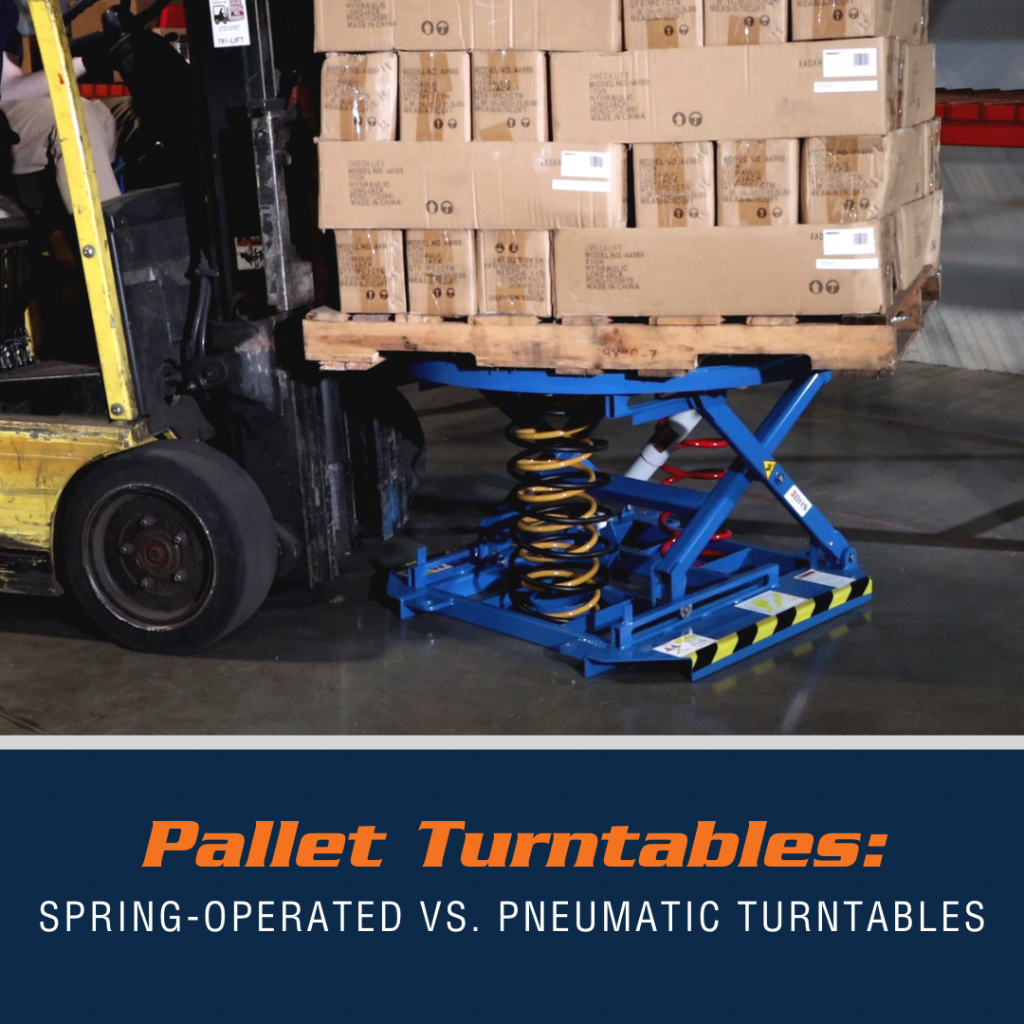We use cookies to make your experience better. To comply with the new e-Privacy directive, we need to ask for your consent to set the cookies. Learn more.
Pallet Turntables: Spring-Operated Vs. Pneumatic Turntables
The manufacturing and warehousing industry completely depends on pallets, and that won’t change anytime soon. The global use of pallets is expected to increase through 2026, and pallet turntables allow operations to maximize throughput through better ergonomics. Improvements in pallet loading/unloading procedures can translate to a safer, more efficient facility.

Manual loading & unloading of pallets causes more injuries than most other common tasks in the material handling industry. Unnecessary stretching, reaching, stooping, or bending by workers can cause serious musculoskeletal issues, but proper ergonomics minimizes the risk. Pallet turntables are rotating, self-leveling stands that adjust automatically as workers add or remove products. The load is always kept within the worker’s reach, which results in higher throughput and fewer ergonomic hazards.
Pallet turntables typically use one of two technologies to provide this functionality: pneumatic or spring-assisted. Both types of turntable can be useful, but you’ll need to consider your facility’s workflow and floorplan to make the best possible decision.
Here’s an overview of the advantages of each option:
- Spring-operated pallet turntables can be deployed anywhere. These pallet turntables use mechanical springs to automatically adjust the work platform. Because the self-leveling feature is completely mechanical, the turntable will counterbalance weight without a power source. However, some modern pneumatic units only require a compressor for operation — we’ll discuss this in detail later in this article.
- Some spring-lift turntables require less maintenance. The simple counterbalancing mechanism uses few moving parts, potentially resulting in a greater ROI over time.
- Pneumatic pallet turntables offer smoother operation. Spring-lift turntables rely on gravity, and loads can bounce slightly when heavy weights are added or removed. Most operators won’t notice much of a difference, but pneumatic turntables may be a better option when this movement could cause inefficiencies. This can also be addressed by choosing spring-operated turntables with dampeners.
- Neither option requires electrical power. Pneumatic turntables inflate and deflate airbags to adjust the height of the platform, so they usually require a compressor or shop air to fill the airbags. However, they do not require electrical power. They can be easily moved around a facility, allowing for greater flexibility for re-shaping your floorplan or adding new workstations.
Ultimately, any pallet turntable offers enormous advantages over a stationary platform, but facilities that depend on extreme precision usually choose pneumatic models. In most manufacturing and warehousing environments, spring-operated carousels offer simpler operation with nearly identical features.
However, you’ll need to consider your operation’s needs carefully when choosing pallet handling equipment. Certain features may drastically improve productivity — and minimize ergonomic hazards — allowing your business to get more from its investment.
Choosing Pallet Turntables and Skid Positioners for Your Facility
The BHS Pallet Carousel & Skid Positioner (PCP) is available with either a spring-operated or pneumatic configuration, both of which can improve ergonomics and throughput in any operation. Our engineers focused on the issues that affect workers during palletizing and unloading tasks, and the PCP’s extensive customization options meet the needs of lean manufacturers looking for simple ways to improve workflow.
Key features include:
- Versatile Work Positioning - Both versions of the Pallet Carousel & Skid Positioner can automatically position loads between 10.5 and 27.75 inches (267 and 705 millimeters). Workers can stand right next to the small base, allowing for better ergonomics.
- Full 360° Rotation and Custom Tabletops - Sealed ball bearings allow the PCP’s tabletop to be smoothly rotated, bringing the pallet load to the worker. Circular and square tabletops are available, and custom options can be engineered to meet your facility’s unique needs.
- High Capacity - Both versions of the PCP feature a 4,500-pound (2041-kilogram) maximum capacity, with a minimum 400-pound (181-kilogram) required for self-leveling operation. The spring-operated PCP uses a combination of one to three springs for consistent positioning, while the pneumatic version uses a 7-ply reinforced airbag.
- Smooth Operation - The spring-loaded Pallet Carousel & Skid Positioner uses a dampener to minimize bounce, removing one of the main disadvantages of spring-operated turntables. The pneumatic version includes a pressure relief valve and requires no electrical power — it can be completely disconnected from a compressor once the airbag is inflated.
Whether you’re upgrading your palletizing workstations or improving ergonomics on an assembly line, the BHS Pallet Carousel & Skid Positioner offers tremendous value. To explore customization options or for more information, contact our team at 1.800.BHS.9500.
